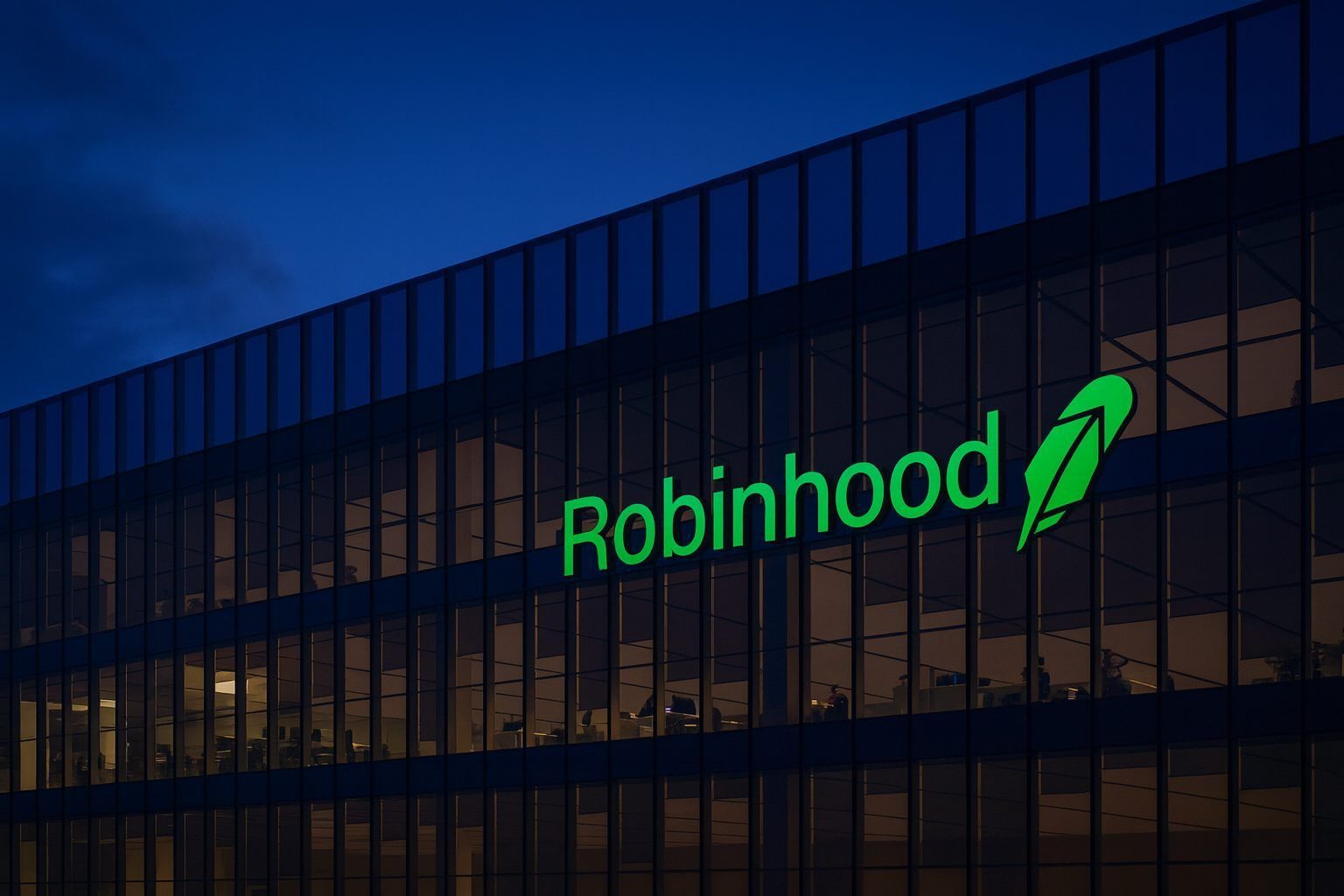Robinhood Markets (NASDAQ: HOOD) is once again in the market spotlight on Tuesday, November 25, 2025. After a meteoric run of a little over 200% year to date that has pushed the online brokerage’s valuation to roughly the $100 billion mark, the stock is now consolidating in the mid‑$110s as investors weigh record earnings, surging crypto activity, and a demanding valuation. [1]
This article looks at HOOD’s price action today, the latest financial results and operating data, how Wall Street currently views the stock, and the key risks and catalysts to watch next. It is for information only and should not be taken as investment advice.
HOOD stock price today (November 25, 2025)
As of late trading on Tuesday, November 25, Robinhood shares are changing hands around the mid‑$110s per share, after trading in a roughly $109–$116 intraday range. [2]
That leaves HOOD only slightly above Monday’s close near $115, but still dramatically higher than where it started the year and close to three times its level a year ago. Over the last 12 months, multiple analyses have noted that Robinhood’s stock has nearly tripled, and its market cap has climbed from tens of billions to just over $100 billion. [3]
Trading activity remains brisk. Today’s volume is around 17 million shares—below the frenzied levels seen right after earnings, but still roughly half the 35‑million‑plus average daily volume that HOOD has posted in recent weeks. [4]
Despite the huge year‑to‑date gain, the stock has been choppy lately. Zacks data show HOOD down more than 20% over the last month, even as the S&P 500 slipped only about 1%, underscoring how quickly sentiment can swing in a high‑beta name like this. [5]
From “broken IPO” to 2025 market star
Just a few years ago, Robinhood was widely described as a “broken IPO.” By early 2022, the stock had sunk to roughly 60% below its 2021 $38 IPO price after the meme‑stock boom faded and the company faced regulatory scrutiny over its payment‑for‑order‑flow model. [6]
That narrative has flipped. Recent coverage notes that HOOD has nearly tripled over the last year, while its market cap has risen more than 200% year on year as the company transformed itself into a highly profitable, fast‑growing platform. [7]
Several factors are behind the turnround:
- Higher interest rates, which boosted interest income on customer cash and margin balances. [8]
- Reaccelerating trading activity, especially in options and cryptocurrencies. [9]
- An expanded product suite, including prediction markets, new social features and broader investing tools designed to keep customers engaged. [10]
The result is a business that looks very different from the one that struggled through the post‑meme‑stock hangover.
Earnings momentum: record Q3 2025 results
The core fundamental driver of HOOD’s 2025 rally has been a string of much stronger earnings reports, capped by blowout third‑quarter results earlier this month.
On November 5, Robinhood reported Q3 2025 results for the quarter ended September 30: [11]
- Total net revenue: about $1.27 billion, up 100% year over year.
- Transaction‑based revenue: around $730 million, up roughly 129% vs. Q3 2024.
- Net interest revenue: about $456 million, up roughly 66% year over year.
- Other revenue (including Robinhood Gold): roughly doubled year over year.
That revenue surge flowed through to the bottom line:
- Net income: approximately $556 million, up 271% year over year.
- Diluted EPS: $0.61 versus $0.17 a year earlier. [12]
Commentary from outlets ranging from FX and equities news to TV personalities like CNBC’s Jim Cramer has emphasized how Q3 marked one of Robinhood’s most profitable quarters ever, powered by both robust trading and interest income. [13]
A closer look at the revenue mix shows why the stock behaves so much like a leveraged bet on market activity:
- Crypto trading revenue grew roughly 300% year over year in Q3.
- Equities trading revenue rose about 132%, and options revenue about 50%.
- Average revenue per user (ARPU) climbed roughly 82% to around $191. [14]
That mix—heavy on transaction revenues and interest income—helps explain both the explosive earnings growth and the stock’s sensitivity to swings in trading sentiment and interest rates.
October 2025 operating data: growth still accelerating
Q3’s momentum didn’t end with the quarter. On November 13, Robinhood released detailed October 2025 operating metrics that give a real‑time feel for how the business is trending. [15]
Key highlights:
- Funded customers reached 27.1 million, up about 210,000 from September and roughly 2.6 million higher than a year ago. [16]
- Total platform assets climbed to around $343 billion, up 3% month over month and 115% year over year. [17]
- Net deposits in October totaled $5.6 billion, and over the last 12 months Robinhood has attracted $68.7 billion in net new assets—about a 43% annual growth rate relative to October 2024 assets. [18]
Trading activity remains intense:
- Equity notional trading volume was roughly $320.1 billion in October, up 153% year over year.
- Options trading hit about 266.7 million contracts, up 69% year over year.
- Crypto notional trading volume reached about $32.5 billion, up an eye‑popping 480% year over year, including both the Robinhood app and Bitstamp. [19]
On the balance‑sheet side:
- Margin balances ended the month at about $16.5 billion, 166% higher than a year ago.
- Total cash sweep balances were about $34.2 billion, up 34% year over year despite a small month‑to‑month dip.
- Securities lending revenue hit $60 million in October, more than tripling year over year. [20]
Taken together, those metrics show a platform that is not only bigger, but also more heavily traded and more leveraged than a year ago—powerful drivers when markets are hot, but potential sources of volatility if conditions cool.
New growth engines: prediction markets, social features and more
Beyond traditional trading, Robinhood is working to diversify its revenue. One of the most talked‑about new products is Robinhood Prediction Markets, which allows users to trade event contracts tied to outcomes like macro data or major events.
According to commentary highlighted by Nasdaq and Bernstein research, Robinhood’s prediction markets business has already surpassed $100 million in annualized revenue less than a year after launch and, based on recent volume, is tracking toward a $300 million revenue run rate. [21]
CEO Vlad Tenev has said the platform has handled about 4 billion event contracts all‑time, with more than 2 billion traded in Q3 alone, and that the company plans to expand prediction markets internationally, engaging regulators such as the UK’s Financial Conduct Authority. [22]
Other growth initiatives include:
- Robinhood Social, meant to increase engagement and sharing among users. [23]
- A planned Robinhood Ventures Fund I, designed to give retail investors access to private companies, including high‑growth AI names historically reserved for institutions. [24]
- Expanded retirement offerings, which leadership says are attracting younger investors opening IRAs as early as 19 years old. [25]
These initiatives are central to the bullish argument that Robinhood can evolve from a boom‑and‑bust trading app into a more diversified financial platform.
How Wall Street sees HOOD right now
Despite the recent pullback, Wall Street’s view of Robinhood is broadly positive—though hardly unanimous.
Across several analyst aggregators, HOOD carries a “Buy” or “Moderate Buy” consensus rating:
- MarketBeat reports that, over the last 12 months, 23 analysts have issued ratings on Robinhood: 14 buys, 8 holds and 1 sell, for an overall “Moderate Buy” rating. [26]
- StockAnalysis and other platforms show 21–23 covering analysts with an aggregate “Buy” recommendation and an average 12‑month price target around $120. [27]
- TipRanks and other services that track analyst forecasts place the average target much higher, in the $150 range, implying more than 40% upside from the mid‑$110s. [28]
In fact, QuiverQuant data show that 18 analysts have set price targets on HOOD over the last six months, with a median target of about $149 and several high‑profile firms—including Citizens, Mizuho, Barclays and Cantor Fitzgerald—issuing targets between $155 and $180 following Q3 earnings. [29]
On the estimate side, Zacks highlights that: [30]
- Consensus 2025 EPS is around $1.95, roughly 79% above last year.
- Consensus 2026 EPS is about $2.27, implying another 16% growth.
That positive revision trend has earned HOOD a Zacks Rank #1 (Strong Buy)—their highest rating. [31]
However, valuation is a sticking point. The stock now trades at roughly high‑40s to around 60 times trailing earnings, depending on the data provider, far above the broader market and most traditional brokerages. [32] Zacks assigns HOOD an “F” value score, explicitly flagging it as expensive versus peers. [33]
What big money and influential investors are doing
Institutional and well‑known investors have been active in Robinhood throughout 2025.
- A recent analysis from Alger Mid Cap Growth Fund singled out Robinhood as a “strong investment”, emphasizing its rapid asset growth, product innovation and improving profitability. [34]
- Zacks recently highlighted Robinhood as one of three “crypto‑centric” stocks to buy on the dip—alongside Nvidia and Interactive Brokers—citing nearly 79% expected earnings growth this year and its Zacks Rank #1. [35]
- A November 25 piece titled “Cathie Wood Goes Shopping: 3 Stocks She Just Bought” noted that ARK Invest founder Cathie Wood added Robinhood shares alongside Coreweave and Circle, reinforcing the stock’s appeal among aggressive growth investors. [36]
QuiverQuant’s tracking of institutional portfolios shows large asset managers such as Vanguard, State Street, BlackRock and Geode Capital significantly increasing their HOOD holdings in Q3 2025, even as some hedge funds took profits. [37]
This mix of strong institutional buying and targeted profit‑taking is typical for a stock that has run as far and as fast as Robinhood has in 2025.
Volatility and key risks
For all the excitement, HOOD is not a low‑risk story. Several recent articles—and the stock’s own performance—highlight important risks:
- Extreme volatility
- Zacks notes that Robinhood shares have fallen about 21% over the past month, even after being up well over 200% year to date, making it far more volatile than the overall market. [38]
- A detailed analysis on Seeking Alpha described the stock as “up more than 220% YTD” and argued that a retracement was likely before any next breakout, mainly due to stretched valuation and positioning. [39]
- Reliance on trading and crypto cycles
- Q3 and October data show that crypto, equity and options volumes have exploded, especially crypto, which saw 480% year‑over‑year growth in October notional trading volume. [40]
- Coverage from CoinCentral highlighted how HOOD fell sharply—about 8% on one day—despite strong earnings, as investors worried about whether trading volumes, particularly in crypto, were peaking. [41]
- Regulatory and product‑mix risk
- Robinhood still operates under close regulatory scrutiny after past controversies around meme‑stock trading and payment for order flow. [42]
- Its newer products, including prediction markets and more exotic event contracts, may attract additional oversight as regulators globally grapple with how to treat these offerings. [43]
- Valuation sensitivity
- With HOOD priced at roughly 50x+ earnings, even small disappointments in growth or monthly metrics could trigger sharp pullbacks as investors recalibrate expectations. [44]
For short‑term traders, that volatility can be a feature rather than a bug. For long‑term investors, it’s a risk that needs to be sized carefully.
What to watch next for HOOD stock
Looking beyond today’s price action, several concrete catalysts and data points are likely to drive HOOD over the coming weeks and months:
- Monthly operating updates
Robinhood’s monthly metrics—particularly net deposits, total platform assets, trading volumes and margin balances—have become must‑watch indicators for investors. Sustained double‑digit year‑over‑year growth in these figures would help justify current expectations; any slowdown, especially in crypto volumes, could weigh on the stock. [45] - Crypto market conditions
HOOD’s revenue mix and recent Zacks commentary make it clear the company now behaves partly like a crypto‑levered financial stock. Articles from Zacks and others have framed Robinhood as a “crypto‑centric” play alongside names like Nvidia and Coinbase, meaning major moves in Bitcoin and other digital assets can quickly spill into the stock. [46] - Progress in prediction markets and new products
Investors will be watching whether prediction markets can maintain or exceed that $100 million‑plus annual run rate and move closer to the $300 million trajectory suggested by recent analysis. Expansion into new geographies and the launch of vehicles like Robinhood Ventures Fund I may also widen the addressable market. [47] - Interest rate path and cash yields
Higher interest rates have been a tailwind, boosting net interest revenue and making products like Gold more attractive. A meaningful shift in rate expectations—higher or lower—could change the contribution from interest income and alter the overall growth profile. [48] - Next earnings report (Q4 2025 / FY 2025)
Consensus currently expects Q4 EPS around the high‑$0.50s and full‑year EPS near $1.95. How management guides for 2026, and whether earnings continue to beat expectations, will be critical for sustaining the bull case. [49]
Bottom line: HOOD today
On November 25, 2025, Robinhood stock sits at the intersection of powerful momentum and substantial risk:
- The company is delivering triple‑digit revenue and profit growth, with user numbers, assets and trading activity all rising sharply. [50]
- New products like prediction markets and institutional‑style funds have the potential to add meaningful, more diversified revenue streams. [51]
- Wall Street largely rates the stock a buy, with a cluster of high price targets, while major asset managers have continued to accumulate shares. [52]
At the same time, HOOD is:
- Expensive by almost any traditional metric, with a valuation that assumes continued rapid growth. [53]
- Tied closely to volatile trading and crypto cycles, which can turn earnings momentum into earnings pressure if volumes normalize. [54]
- Prone to sharp drawdowns, as the last month’s 20%‑plus decline despite strong fundamentals demonstrates. [55]
For aggressive, risk‑tolerant investors, Robinhood may remain an attractive way to bet on the continued democratization of trading, the growth of crypto, and new forms of financial speculation like prediction markets. More conservative investors, however, may prefer to watch from the sidelines, waiting for a better entry point or for the company to build a longer track record of durable, less cyclical earnings.
Either way, HOOD is likely to stay on the list of the market’s most closely watched—and most hotly debated—stocks as 2025 draws to a close.
References
1. www.smartkarma.com, 2. public.com, 3. www.nasdaq.com, 4. public.com, 5. finviz.com, 6. www.sharewise.com, 7. www.nasdaq.com, 8. fxnewsgroup.com, 9. www.investing.com, 10. www.investing.com, 11. www.globenewswire.com, 12. www.globenewswire.com, 13. fxnewsgroup.com, 14. www.nasdaq.com, 15. www.nasdaq.com, 16. www.nasdaq.com, 17. www.nasdaq.com, 18. www.nasdaq.com, 19. www.nasdaq.com, 20. www.nasdaq.com, 21. www.nasdaq.com, 22. www.nasdaq.com, 23. www.investing.com, 24. www.nasdaq.com, 25. finviz.com, 26. www.marketbeat.com, 27. stockanalysis.com, 28. www.tipranks.com, 29. www.quiverquant.com, 30. finviz.com, 31. finviz.com, 32. finance.yahoo.com, 33. finviz.com, 34. finance.yahoo.com, 35. www.tradingview.com, 36. www.fool.com, 37. www.quiverquant.com, 38. finviz.com, 39. seekingalpha.com, 40. www.nasdaq.com, 41. coincentral.com, 42. www.nasdaq.com, 43. www.nasdaq.com, 44. finance.yahoo.com, 45. www.nasdaq.com, 46. www.tradingview.com, 47. www.nasdaq.com, 48. fxnewsgroup.com, 49. seekingalpha.com, 50. www.globenewswire.com, 51. www.nasdaq.com, 52. www.marketbeat.com, 53. finance.yahoo.com, 54. www.nasdaq.com, 55. finviz.com







